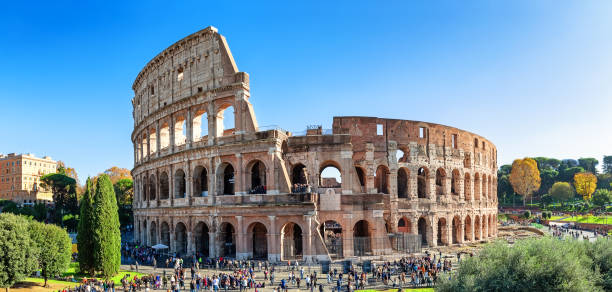Key Takeaways
- The Colosseum in Rome is an architectural marvel and a symbol of cultural heritage.
- Its historical significance continues to inspire modern architecture and entertainment venues worldwide.
- The enduring allure of the Colosseum can be seen in film, literature, and cultural festivals.
- Sustainable tourism practices are essential for preserving such monuments for future generations.
A Glimpse into the Past: The Colosseum’s Magnificence
The majestic Colosseum in Rome isn’t merely a relic of the past; it’s a living testament to the grandeur of ancient civilizations. Often featured in Roman Colosseum tours, this iconic monument represents the high watermark of Roman architectural innovation and cultural zeal. Completed around AD 80, the Colosseum was an epicenter for entertainment, hosting thrilling gladiatorial combats, hunts, and mock sea battles witnessed by an audience of up to 80,000. This architectural ingenuity highlights the Romans’ sophisticated engineering and commitment to public entertainment.
Over the centuries, the Colosseum has assumed various roles, from an amphitheater to housing initiatives, demonstrating its adaptability and importance in different eras. Despite enduring earthquakes, stone robbers, and time itself, its captivating arches and remnants of painted frescoes continue to attract millions of tourists eager to step into the footsteps of Roman citizens of the past.
Modern Architectural Influence and Global Impact
The Colosseum’s design philosophy reverberates through modern architecture in unexpected ways. Its tiered seating arrangement and efficient space utilization have served as blueprints for countless sports stadiums and concert halls worldwide. Contemporary architects often emulate these attributes, striving to recreate the balance of aesthetics and functionality this ancient megastructure exemplifies. The use of arches for both support and aesthetic appeal is a signature feature that continues to influence stadium and arena designs across continents.
Explorations into the influence of the Colosseum on current architectural practices reveal an ongoing relationship between ancient and contemporary ideas, where timeless principles are woven into the fabric of modern construction. This connectivity to Rome’s architectural past enriches global architectural landscapes and nurtures a continuity of human ingenuity and ambition.
The Colosseum’s Role in Literature and Film
The Colosseum’s cultural significance extends beyond the physical realm, capturing the imagination of both writers and filmmakers. Its iconic ruins serve as a poignant literary symbol and a dramatic backdrop in cinema. Films such as “Gladiator” have embedded the amphitheater into global consciousness, intertwining history and entertainment to alluring effect. The Colosseum has become synonymous with tales of heroism, struggle, and the human spirit in adversity, transcending the confines of time.
Recent film narratives show that the appeal of historically rich settings has increased, providing fertile ground for narrative depth and visual grandeur. The Colosseum remains a favorite backdrop, encapsulating the drama and intrigue of its storied past while enhancing the allure of fictional and non-fictional storytelling.
Global Cultural Festivals Celebrating Roman Legacy
Around the globe, festivals inspired by the grandeur of Roman culture highlight the Colosseum’s timeless relevance. These festivities, often reminiscent of ancient Roman celebrations, range from reenactments of gladiatorial bouts to interactive Roman-themed fairs. They serve an educational purpose, allowing participants to engage with history vividly and viscerally.
These celebrations rejuvenate the Colosseum’s legacy and foster a cross-cultural appreciation for ancient Roman societal contributions. They underscore the importance of historical education, creativity, and cultural exchange in bringing the past alive in a way that resonates with today’s audiences and creates a shared historical consciousness.
Preserving History: Sustainable Tourism Practices
The Colosseum’s enduring appeal necessitates a commitment to its preservation through sustainable tourism practices. Balancing visitor access while safeguarding this iconic monument is a delicate act. The ongoing regulation of visitor numbers ensures both the protection of the structure’s integrity and the enhancement of the visitor experience, allowing history enthusiasts to appreciate the monument responsibly.
Preservation efforts include careful restoration projects employing traditional techniques and innovative technologies. Protecting the Colosseum and its environs from the impact of climate change and urban pollution remains paramount, ensuring future generations can similarly be awed by its grandeur.
Global Collaborations in Museum and Restoration Efforts
International collaborations are pivotal in preserving and disseminating Roman cultural heritage. Museums and heritage organizations worldwide participate in projects emphasizing knowledge sharing, resource pooling, and technical expertise in conserving ancient marvels like the Colosseum.
Traveling exhibitions curated by these global collaborations help extend the reach of Roman culture, offering audiences worldwide access to the rich history and artistic accomplishments of this once mighty empire. These efforts underscore the importance of safeguarding our shared global heritage, fostering a deeper understanding and appreciation that transcends geographic and cultural boundaries.
A Living Legacy: The Colosseum’s Enduring Appeal
The Colosseum, emblematic of antiquity’s splendor and architectural prowess, continues to captivate as a monumental relic of human achievement. Its story unfolds with each weathered stone and shadowed corridor, inviting exploration and reflection from every visitor drawn to its timeless allure.
Efforts to preserve and learn from such historical wonders as the Colosseum contribute to an ongoing cultural continuity, innovation, and resilience narrative. As living vestiges of the Roman Empire, they are symbols of humanity’s undying quest for excellence, adventure, and legacy.


